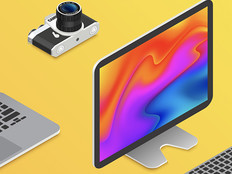Three-Year Tune-Ups
Like any machine, a computer’s performance declines over time. You can, however, restore these tools to top performance — even after years of service. In many cases, a refreshed PC will perform better than a new one after a few relatively minor improvements.
Here are six options for extending the service life of your PCs:
-
-
Option 1: Clean House
Microsoft Windows users can start optimizing by performing a disk clean-up. To do this, right-click the system’s hard drive and go into the Properties menu. This will clear temporary files that not only take up space but also can degrade performance and slow disk-maintenance utilities.
Users looking to free up additional hard-drive space should also uninstall any old programs that they no longer use. Not only will this create more available storage, but it can also reduce the number of programs running in the System Tray in the bottom right corner of the screen. That ink-jet printer may be dead and gone, but many resource-hungry printer utilities will stick around in the System Tray whether the printer is there or not, consuming valuable processor time and system memory.
Make a System Tray audit part of your regular house cleaning. Look at each icon and ask, “Do I really need that?” Because these programs are constantly running, be mindful that they are taxing your system and making it boot more slowly. Often, permanently disabling these programs can be as simple as right-clicking their respective icons and accessing a Settings or Properties context menu.
Benefit: Improves system performance at zero cost. Hardware upgrades typically go down in price over time, making future upgrades less expensive.
Applies to: desktop and notebook systems
-
Option 2: Start Over
When a machine is too far gone to clean up but too new to replace, one option is to wipe the hard drive clean and install everything (including the operating system) from scratch. It’s easy to forget that a computer can still do everything it did the day it was purchased and that a general decrease in speed often results from intangible clutter. A registry full of unused keys; remnants of old programs, drivers and dynamic link libraries that have long since been upgraded and are no longer used; fragmentation; and a litany of other variables are just a few things a well-used computer fights against when performing even the most basic tasks.
Though the potential exists with any undertaking, starting over doesn’t automatically mean hours of labor. Most systems today come with recovery media or diagnostic partitions, and many times, reloading can be as simple as hitting a key during startup or inserting a recovery disk and following on-screen instructions. Whatever method you use, don’t forget to back up your files before reloading: Factory configuration means factory configuration.
Benefit: The clean-sweep approach costs nothing, and you can restore the computer to brand-new performance. It’s a one-stop shop to remove anything software-related that’s wrong with the computer.
Applies to: desktops and notebooks
-
Option 3: Increase Memory
When cleaning house isn’t enough, the first and most painless upgrade is to increase memory. Memory slots are easily accessible on most desktops: Simply remove the side cover and look near the processor. Many of today’s notebook designs make it easy to upgrade; the best-case scenario requires simply removing the cover on the bottom of the notebook. The cardinal — and often overlooked — rule in upgrading memory is to arm yourself with appropriate knowledge beforehand. Take this short test before making your purchase:
1. What type of memory does the computer require? Memory comes in many speeds and form factors. Some memory requires that upgrades be done in pairs. Some types of memory let faster chips be used in place of lower-speed memory. Consult your computer manual or even your manufacturer’s Web site to be sure. If you still can’t find an answer, you may be able to glean this information by pulling the existing stick of memory and simply looking at it or doing a Web search on the manufacturer’s part number. CDW’s Web site also offers handy “memory configurator” tools that may prove useful when trying to determine what type of memory your computer requires.
2. How many memory slots are available? This can be determined in a variety of ways, including those listed previously or by pulling up the machine’s BIOS utility and looking at the “memory” configuration. Most BIOS utilities will show installed memory and available slots in a simple, straightforward fashion.
3. How much memory can the computer hold? Many people don’t realize that system motherboards have limitations on how much memory they can recognize. Nobody wants to find out that his or her system will recognize only 2 gigabytes of a 4GB upgrade (or worse yet, not boot at all). In some cases, these limitations can even interfere with a BIOS upgrade. Whatever the requirements, this is definitely homework you will want to do ahead of time.
4. How easy is this going to be? Unless you welcome the prospect of an unexpected challenge, you will want to make sure you don’t fall into the minority of users whose systems are unusually difficult to work on. I’ve seen desktop systems that had to be gutted to get to the RAM slots, and I’ve seen notebooks that have RAM slots only accessible by removing the keyboard. It takes just a few minutes to do the appropriate research to let you plan with confidence.
Benefit: Immediate increase in speed because the virtual memory holds less cached data. Most upgrades take even inexperienced users less than 10 minutes to perform.
Applies to: desktops and notebooks
-
Option 4: Increase Storage Capacity
Given the robust nature of today’s productivity software and the proliferation of multimedia in both home and business applications, it’s no wonder that storage needs often outgrow a machine’s initial capacity. Fortunately, increasing storage is relatively painless. For desktop users, adding a second internal hard drive doesn’t normally affect the existing system drive and takes only a few minutes to install. Notebook users have options, too. Depending on the notebook model, it may be possible to add an additional hard drive by using an available expansion bay.
If the notebook has no extra bay available or if a more temporary solution is desired, USB hard drives are relatively inexpensive, convenient alternatives — just plug in and go. Many models even come conveniently pre-formatted.
Benefit: Get an immediate and affordable increase in storage capacity with relatively little labor.
Applies to: desktops and notebooks
-
Option 5: Upgrade the Video Card
Although most people generally associate graphics accelerator cards with computer gaming, they are necessary for many businesses that use computer-aided design applications and other design programs. Couple that with the fact that many marketing teams now create their own multimedia presentations, and it’s little surprise that more companies than ever are deploying media-ready PCs. Because video acceleration is important in these types of environments, don’t overlook the video card when considering system upgrades.
Replacing the video card on a desktop computer is relatively quick and easy. In most cases, simply uninstall the old video drivers, shut down, remove the old card, replace the card, then boot back up and install the new drivers. While most video cards come with a driver CD, these are often obsolete by the time the card ships, which is why it is advisable to check the vendor’s Web site for updated drivers. Once drivers are installed, the upgrade is generally complete, although in some instances, you may need to re-install some video-accelerated applications.
Benefit: Increased performance for demanding applications for relatively little expense when weighed against the cost of a new system.
Applies to: most desktops; some newer notebooks
-
Option 6: Upgrade the Processor
Although upgrading processor speed is an advanced approach, it is the ultimate answer if you need to dramatically boost performance without buying a new machine. Many PCs ship with motherboards capable of supporting much higher clock speeds than that of the included processors, making upgrades as simple as removing and replacing the processor. In other instances, units come maxed out or with soldered processors and require that your replace the motherboard to upgrade processor speed. If this is the case, research what else will be involved. Many times, a larger power supply or different type of memory will also be necessary to support the higher clock speed. Another thing to consider is that in most cases, you will need to reinstall the operating system. So, do the upfront research and plan accordingly.
Benefit: Highest impact to improve performance.
Applies to: desktops only
-






